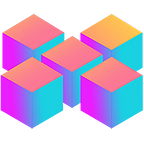What in the world are Modular Blockchain Design
Before we go into a deep dive on what modular blockchains are, let’s do a little bit of an introduction for those who do not know what blockchains are.
WHAT IS A BLOCKCHAIN?
A blockchain is a distributed database existing on multiple connected computers at the same time.
In more techie terms, this is an example of Distributed Ledger Technology (DLT).
Instead of all data being housed in one device, blockchains use networks of peer-to-peer connected computers called nodes.
Each node has up-to-date records of transactions (the data) that are being carried out in the chain (hence, decentralized!). Again, going back that blockchain is essentially a database.
BLOCKCHAIN APPLICATIONS
The nature of blockchain has paved the way for the evolution of cryptocurrencies, NFTs, and dApps — to name a few.
These applications are just a matter of writing programs that will run on the chain, and that program will leverage the features of the blockchain. You can build simple todo-apps that run on the blockchain and only use a single part of a blockchain’s feature.
Now that we’ve gotten that out of the way, let’s get down to business!
MONOLITHIC BLOCKCHAIN DESIGN vs. MODULAR BLOCKCHAIN DESIGN
At present, there are two existing popular blockchain designs — monolithic and modular.
A monolithic blockchain is a more traditional design that most blockchain projects use for their current networks.
They try to accomplish three things: consensus, execution, and data availability.
The main problem with these blockchains is that they are bound by the “blockchain trilemma”. Since the blockchain is responsible for providing the three underlying components that make a blockchain, optimizing one of the attributes will invariantly affect the other two.
Although monolithic blockchains have taken us so far, now they are reaching the limits of scalability.
The era of monolithic blockchains is coming to an end.
The development of blockchains is reaching a new level of maturity.
It is now clear that the next stage of blockchain development is modular design architecture.
In this design, attributes that make the blockchain a “blockchain” are showing more differentiation, so that each chain can realize its own optimal vision.
With the modular design architecture, blockchain engineers can utilize the blockchain and its features to their full potential.
Decentralization, scalability, and security. The works!
The modular blockchain divides these components into separate parts and maximizes them — consensus, execution, and data availability.
With this design, you can now choose and implement your own consensus, execution, and data availability.
A blockchain engineer can now then group or separate these components and reduce the time for development as well as be able to scale these components individually depending on the need.
The era of modular blockchains is here.
— -
If you want to learn more about modular blockchain, head on over to the Tetrix website.
